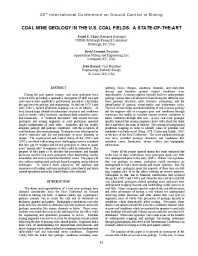Mining Publication: Coal Mine Geology in the U.S. Coal Fields: a State-of-the-art
Original creation date: August 2006
During the past quarter century, coal mine geologists have evolved from providing a qualitative description of drill core and coal reserves into quantitative geotechnical specialists who bridge the gap between geology and engineering. In the late 1970's and early 1980's, hazard prediction mapping was in its infancy. At best, hazard maps identified rudimentary structures and conditions such as stream valley locations, sandstone/shale transition zones, and lineaments. A "technical disconnect" had existed between geologists and mining engineers as each profession operated largely independent of each other. Engineers did not readily integrate geology and geologic conditions, with the exception of coal thickness, into mine planning. Geologists were relied upon for reserve estimates and did not participate in mine planning or design. The employment and market slump of the 1980's and 1990's combined with mining more challenging reserves mandated that this gap be bridged and forced geologists to learn to speak more "numerically" to engineers so they could be understood. The purpose of this paper is to describe the procedures and thought processes used by coal mine geologists when determining various mineability and reserve extraction feasibility issues. The paper will also address underground geologic hazard mapping and prediction techniques. To achieve these objectives, the opinions and experiences of leading coal mine geologists, geotechnical and strata control specialists across the United States were solicited.
Authors: FE Chase, D Newman, J Rusnak
Conference Paper - August 2006
NIOSHTIC2 Number: 20030805
Proceedings of 25th International Conference on Ground Control in Mining, August 1-3, 2006, Morgantown, West Virginia. Peng SS, Mark C, Finfinger G, Tadolini S, Khair AW, Heasley K, Luo Y, eds., Morgantown, WV: West Virginia University, 2006 Aug; :51-56
See Also
- Analysis and Prediction of Longwall Methane Emissions: A Case Study in the Pocahontas No. 3 Coalbed, VA
- An Approach to Identifying Geological Properties from Roof Bolter Drilling Parameters
- Design Methods to Control Violent Pillar Failures in Room-and-Pillar Mines
- Detecting and Managing Dynamic Failure of Near-Seam Features in Coal and Nonmetal Mines
- A Gas Pressure-Based Drift Round Blast Design Methodology
- New Developments with the Coal Mine Roof Rating
- Roof Support
- Technology News 493 - Proceedings: New Technology for Coal Mine Roof Support
- Technology News 516 - ARMPS-HWM: New Software for Sizing Pillars for Highwall Mining
- Technology News 526 - Proceedings of the International Workshop on Rock Mass Classification in Underground Mining
- Page last reviewed: 9/21/2012
- Page last updated: 9/21/2012
- Content source: National Institute for Occupational Safety and Health, Mining Program


 ShareCompartir
ShareCompartir
